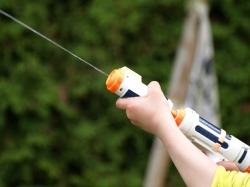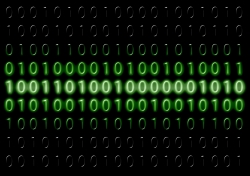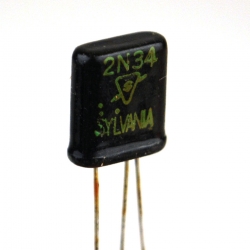Let's learn about electronics . . . in a swimming pool! No, we aren't going to take the electronics into the pool. That would be crazy. They would all break. Instead, we're going to use the waves in the pool to show how information can be sent from one place to another. Then you can know how telephones and record players and other music players work. Okay, let's jump in.
SPLASH!
Now, I want you to imagine that this water is really air. I know, I know. Stick with me. Air moves around a lot like water does. It's just a lot lighter and you can't see it, which makes it hard to see what's happening. Okay, now move your hand in one big sweep. A
wave is a disturbance that sends particles crashing into each other pushing other particles and on and on . . . Every time you hear a sound it's because something is making air molecules crash into each other all the way to your ear. Imagine the far wall of the pool is an ear. Now send a wave at it. Sssssssssssplash! That's how sound works. When we turn that sound into electricity, it works a little bit differently. Electricity can move without having anything to move through! It just shoots forward . . . more like a squirt gun. SzzzzzzzzzzzT!

OK, maybe not such a big wave.
Of course, a wave doesn't always make it where you want to. It can run into another person who's in front of the wall, or worse, a little kid can jump into the pool on top of the wave, making a lot more waves and splashing the first one in other directions. If a lot of people are trying to splash waves to each other, it will be hard to tell where each wave came from. Your signal did not make it to the wall! Now pay attention. This meaning of noise is going to be different than the one you know.
Noise is extra and unwanted signal that makes it hard to understand a signal or message. So it isn't like a cow mooing or the music you are listening to. It's more like the tractor that doesn't let you hear the cow mooing or the static that won't let you hear the music. Maybe you can't tell what the cow is saying or understand the words in the song. What if the pool was a mile long? Do you think your wave would ever reach that far wall? So you can see that sending information through waves doesn't always work. Time to get out of the pool.

I said w@tch yo#r he@d!
We want to get our signals as far out as we can! To your friend in another country! Up into space to the astronauts! Waves work very well, but can get noisy and will not cut it for everything we need to do. We need something that will still work with noise. We need the squirt gun.
Binary is a way to send data that uses only 1's and 0's. A wave is a big thing and is can be tough to understand if there is a lot of noise. So let's say you wanted to tell someone something. Instead of writing out words or sending waves through the air with your voice, you would just send a lot of 1's and 0's. If you ask your friend for some food in a noisy room, they might not hear you . . . and I know you want that food. With 0's and 1's, it would be easy for your friend to see or hear which number you're using. Learning to talk this way would take you a long time, but it makes things easy to understand for a computer. It may seem a little strange, but this is how every electronic thing you own, from a TV to a phone, uses this way to send information. Lights work like this too - on or off, which is just another way of saying 1 or 0.

But what does it all mean?
Of course, I only showed you how to send numbers. The very first computers used switches to make these 0's and 1's. There would be a huge room full of switches and they could store information with switches being on (for 1) or off (for 0). It takes up a lot of space to have all these big switches around, so someone found a way to make very very small 0's and 1's. All the colors, sounds and information you see on your computer is nothing more than a bunch of 0's and 1's. So where are they all? A
transistor is something that can send and stop signals, or amplify them to make them louder or bigger. By storing information as 0's and 1's they can do most of your favorite things. Over time, transistors have become smaller and smaller so you can fit more and more of them into the things around us. Each of them can store or send more 1's and 0's and send more information more quickly. That's how the computer the size of a room becomes big enough to go in your living room, becomes the size of a phone, becomes the size of a watch . . . Who knows what's next?

This little three legged guy changed the world.
The first ways we used to send information are like splashing waves in a pool. This works well . . . but noise can makes those waves hard to understand. That's why we switched to digital, using ones and zeroes to send information. This works more like a squirt gun. Something pushes it forward. We do this with transistors, which are very small things that send signals inside of computers. If someone ever asks you if pools or numbers are more fun, think about what waves can do. Then think about what ones and zeroes can do . . .
References:Ryan, V. "Transistors" technologystudent.com, 2002 http://www.technologystudent.com/elec1/transis1.htm
Diffen. "Analog vs. Digital" diffen.com, 2013. <
http://www.diffen.com/difference/Analog_vs_Digital>
Expert Maths Tutor. "Physics - Waves - Analogue and Digital Signals" YouTube, 2014. <
https://www.youtube.com/watch?v=XCu6L4kQF3k>